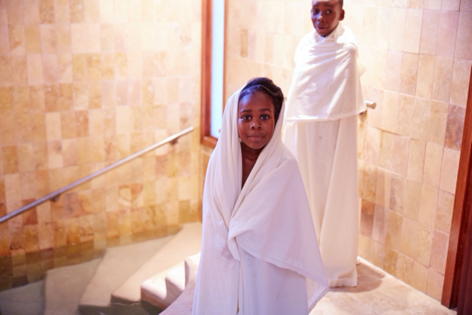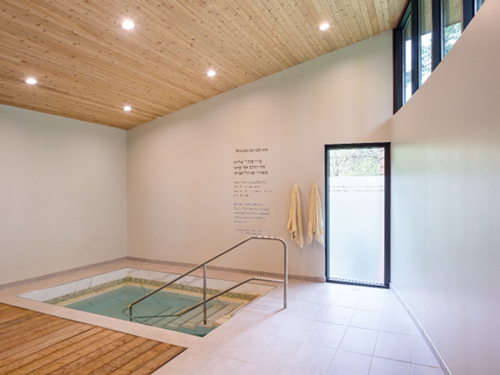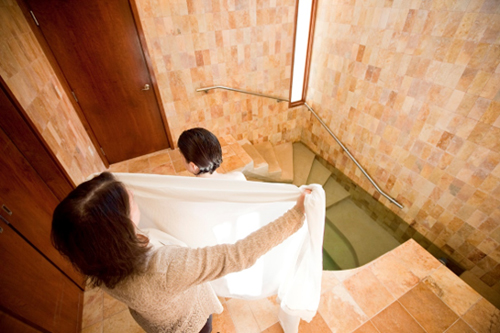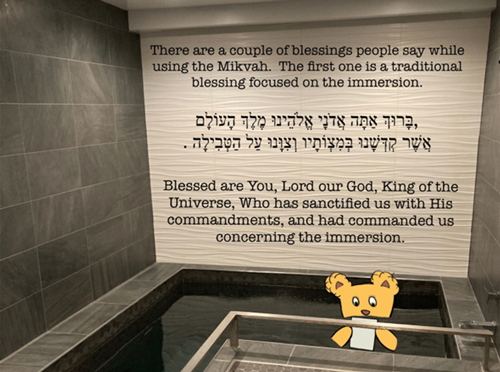What is a Mikvah?, an introduction for families via BimBam
Do you know what a mikvah is? PJ Library siblings adorably describe the mikvah as the "dunkie-dunk." While our young friends are not wrong, there's much more to the ritual bath.
PJ Library checked in with Rising Tide Open Waters Mikveh Network, an organization working to make the mikvah, one of Judaism's most ancient rituals, an experience that's open, inclusive, and accessible for everyone in the Jewish community.
Read on to learn more! (And for a quick crash course, click the video from BimBam above.)
History of the Mikvah
The mikvah, a special type of bath made of naturally occurring (“living”) water, such as a spring or rainwater, is a Jewish practice and mitzvah dating back to ancient times. Immersion in the mikvah is traditionally done for ritual cleansing and purification, conversion, marriage, women's monthly cycles, and other transitional times.

Two mikvah visitors after their immersion at Mayyim Hayyim in Newton, MA.
For example, immersing in the mikvah can help believers prepare spiritually for holidays, including Shabbat and Yom Kippur. People suffering or recovering from illness can benefit from the immersion experience, as it reduces anxiety and helps focus on prayer and relaxation. People also visit the mikvah to mark moments in life, such as becoming b'nai mitzvah (for children or their parents), reaching a certain age, or becoming a parent or grandparent. Passing through the water is a way to help move from one phase or life moment to the next, whether part of a Jewish spiritual journey of marking transitional moments or for reasons related to physical health.
Preparing for the Mikvah
The mikvah is much more than a soothing bath. It's a spiritual practice that takes preparation and kavanah, intention. Mayyim Hayyim offers a step-by-step guide outlining the kavanot to prepare for the mikvah.
In addition to spiritual preparation, immersion also requires physical preparation. Visitors to the mikvah remove all jewelry and makeup and take a cleansing shower or bath beforehand, including removing dirt from under nails and any stray hairs.


A mikvah visitor and attendant at Mayyim Hayyim in Newton, MA.
Immersion in the Mikvah
After the personal preparation, it's now time to enter the mikvah and enjoy its benefits. There are seven steps, symbolizing the seven days of creation, that lead into the warm water. The visitor then completely submerges under the water, so each body part and hair is submerged. This first immersion is followed by a prayer and then, traditionally, two more immersions underwater. Some people choose to say the Shehecheyanu after the final immersion.
Becca Crompton of Adas Israel in Washington DC created a mikvah guide for children, making it easy for kids and grownups to understand the process. Becca reminds us that when we recite the blessing, we completely immerse ourselves in the water, even the tops of our heads and ears.

Excerpt from Adas Israel's mikvah guide
For those interested in visiting a mikvah or learning more about it, many community mikva'ot (plural of mikvah) allow visitors to tour their facility. The Rising Tide Open Waters Mikveh Network has a list of members and partners those interested can use to find a mikvah nearby or get more information about their open, inclusive approach.
More
Mikveh Stories via Rising Tide Open Waters Mikvah Network
The Mikveh's Significance in Traditional Conversion via My Jewish Learning
May 24, 2022